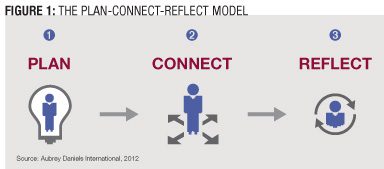“There’s no substitute for experience” is a common adage for those who have learned by doing during a long career. Well-designed learning can help close an experience gap, but the expression still holds truth.
There is a practical limit to a reliance on structured training. Technology and the business environment are changing so quickly, structured training has by necessity taken a back seat to informal learning as the dominant approach to workplace development.
Self-Directed Informal Learning
Experience alone can be an inefficient instructor. Value comes from the relevant and practical takeaways in an experience. High-potential employees are especially effective at generating these takeaways. In his 2011 “Everyday Experience Is Not Enough” blog post, Tom Gram of Performance X Design said, “Experts continually challenge their current performance and seek feedback from their environment to stay in a more or less permanent learning state, mastering everyday skills but continuously raising their personal bar. This deliberate approach to learning from experience is what separates top performers from the norm.”
Whether learning formally or informally, employees at all levels need to take ownership for their development. This goes beyond annual development plans that specify special work tasks and conference attendance. Informal learning shouldn’t be left to chance or reserved for those skilled in making the most of their employment experience.
For Mike Sullivan, chief people officer at breakfast cereal producer MOM Brands, effective informal learning is expected. “Our company is ambitious. For us to win, we need to juggle being a low-cost producer, a growth company and a great place to do great work. The low-cost producer aspect can often be the most challenging.
“For certain investments, we sometimes have an affordability challenge. While we clearly can’t afford poor performers, we also can’t afford a heavy investment in formal training,” he said. “As a result, we expect employees to be accountable for their own development and then provide customized support to make that happen.”
Kevin Munson, chief learning officer at Sears, said that skill nuances in particular are often better learned through experience, and typically employees rely on chance for those situations to come up. “To get the most from informal learning opportunities, employees need to look for and take advantage of those opportunities,” he said.
The Plan-Connect-Reflect Model
Learning organizations should teach employees to extract learning from work events big and small, from mundane meetings and casual interactions to their own behavior and its impact on others. Essentially, the learner will play an active role in orchestrating informal learning activities.
“With informal learning, employees serve as their own instructional designers,” Munson said. “They identify their learning objectives, evaluate their performance against those objectives and arrange or find real-life experiences to address those objectives.”
Employees can integrate informal learning into their daily routine using a three-step model: plan, connect and reflect (Figure 1).

Plan: Employees require two types of planning: initial planning to define long-term learning goals regarding behaviors, skills to be improved and workplace opportunities to accomplish those goals, and daily planning to connect their learning goals with their schedule.
This could include outlining the context for interactions with peers, customers, vendors, leaders and experts in meetings, customer sales or service interactions. While it is the employees’ responsibility to complete the initial planning, the learning leader can drive this activity by establishing clear expectations and providing support for learning aligned with business goals.
“We use a disciplined approach to jumpstart employees’ self-development,” Sullivan said. “We focus them on developing targeted skills that will increase their personal effectiveness, and have them do this as they work to achieve their individual and functional goals … all in alignment with our annual company objectives. This avoids directed informal learning always having to be a ‘plus-one activity.’”
Daily planning is a quick preview of the day’s events and the informal learning opportunities that might surface, such as practicing a new skill. Being primed to look for informal learning opportunities will make it easier to recognize and act on them.
Connect: The connect step requires follow-through on the day’s plan and real-time recognition of unanticipated opportunities for learning. There are five ways employees can connect their learning goals with the day’s activities: practice, impact, observe, listen and set up (Figure 2). Intentionally practicing a skill is likely to be the most prevalent learning opportunity. It could be a technical, management or leadership skill. Ideally, a trusted colleague will be available to provide feedback on the behaviors observed. These feedback loops can be set up in advance or solicited afterward based on who was present.

Munson said it’s also important to have a way to evaluate employees’ impact. “Employees need to ask themselves, ‘How will I know if I’ve done it right? What outcome will I use to evaluate the impact of my behavior?’ How others respond to their performance is a good leading indicator of their success. Specifying the response they want upfront makes it easier for them to give themselves feedback in real time and adjust their behavior on the fly.”
For example, in sales and customer service environments, impact can be measured by identifying the customer response that will demonstrate a successful interaction — such as agreed to meet again or described a specific sales objection — and then evaluating behavior based on the response. Specifying the desired customer response in advance will establish an effective leading indicator to measure the impact of the new behavior on the customer experience.
Employees also can plan to observe exemplars of skills they are trying to master. To extract learning from the observation, the observer should record specifics about what the person did and didn’t do and the impact it had. These behaviors can become situational or overall best practices. Likewise, having anticipated contact with a knowledge expert during the planning step, employees will be in a better position to listen actively, to prompt the expert for more details and to relate that information to their existing knowledge base.
Future opportunities for learning can be set up in conjunction with a new project, attendance at a future meeting or following up with a new contact who might offer connections to the employees’ learning goals. Like a salesperson proficient at generating sales leads, employees actively focused on their learning goals and work environment will be able to generate learning opportunities where others fail.
Reflect: Reflecting on the day’s learning fosters recognition and retention of its nuances. This includes the context of the behavior practiced or observed, the impact of the behavior on others and what actionable specifics led to success or failure. “Reflecting allows employees to evaluate the impact of what they’ve done in the absence of any direct feedback,” Munson said. “It also allows them to connect their learning experiences from the day with past learnings. This helps them identify patterns in what is and isn’t working for them.”
Quick daily note-taking or journaling fosters the identification of trends in skill development and allows progress to be evaluated more easily. Event recording can become a source of self-reinforcement as accomplishments are relived. Many generic journal apps are available to reduce the time and effort required to track and organize learning. While daily planning and reflecting are essential for prompt and sustained learning, these steps need to be relatively quick. Otherwise, the model will become burdensome and its active use likely will end abruptly.
Building Informal Learning Habits
The quickest path to build positive habit strength is through small daily goals and frequent reinforcement. Tracking the use of the plan-connect-reflect model can set up opportunities for that frequent reinforcement (Figure 3). The time and effort required for daily application and tracking will lessen as its use becomes a habit and skills are developed.

Reinforcement can come from many sources, such as self-reinforcement — what people say to themselves about their performance; the natural consequences of how others react to a specific behavior in the moment, such as a positive response from a customer or co-worker; and social reinforcement from peers and managers. Sullivan said he builds scheduled reinforcement into the process. “In our corporate functions, we use development-focused monthly one-on-ones for review, feedback and reinforcement of learning activities from the prior month,” he said. “This is typically an employee-driven meeting. They set the agenda and use their manager as a coach and sounding board.”
Employees also can use technology to build in potential sources of reinforcement and accountability for follow-through. Munson said an internal social networking system supports informal learning at Sears.
“The key to building learning habits is to ensure that the behavior being developed gets timely feedback and reinforcement,” he said. “One way we support this at Sears is through a social networking site where employees share a specific example of a behavior or approach they are working on and the impact that it had. For example, employees often describe an opportunity to provide a positive customer experience, what they did to achieve that and how the customer responded. Others then provide social reinforcement for what they liked and offer suggestions for improvement. This is both a brag board and a help desk for skill refinement.”
Short but disciplined upfront planning will help employees identify opportunities for skill development throughout their normal work day. Once recognized, connected to a personal goal that matters to them, recorded and periodically reviewed, these events will accelerate growth and adaptability. Without these quick but deliberate steps, incidental learning from experience will amount to throwing life against the wall and seeing what sticks.
Tom Spencer is the chief operating officer for Aubrey Daniels International Inc., a management consultancy. He can be reached at editor@CLOmedia.com.















